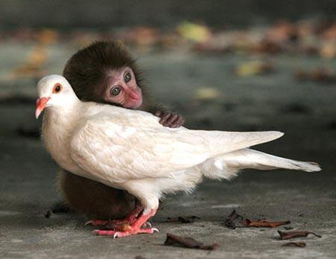 Vulture by Salva Boada (CC BY-NC-ND 2.0)
Vulture by Salva Boada (CC BY-NC-ND 2.0) What this suggests is that the impacts of transforming research practices so that they operate within a paradigm of more-than- human communities are potentially immense. However, shifting conventional research paradigms, many of which remain embedded within Enlightenment philosophies of self-aware humans in a machine-like world, is not a task to be taken at all lightly. Thus while we would like to situate our project within this broader context, we have more modest hopes for our work.
 by hot2008 (CC BY-NC 2.0)
by hot2008 (CC BY-NC 2.0) Inspired by a variety of feminist epistemologies, as well as emancipatory movements from South America and Africa (e.g. Freire 1970 [PDF]), the central components of the co-production agenda have been the desire to support the inclusion of marginalised voices in the research process, to make research accountable to those it affects, and, in the process, to transform the practice of research and knowledge production. To date, discussions of co-production have taken place in a range of areas including public service provision (Verschuere, 2012), health services (Gillard, 2010), management and organisational research (Antonacopoulou, 2010; Orr, 2009), as well as broader debates about science, policy and the public realm (Nowotny, 2001). However, in our current context, where the failure of the enlightenment project to produce knowledges that support sustainable ways of life has become clearly apparent, there are strong incentives to extend this agenda by thinking through what, and who, research might still need to take into account.
Intriguingly, one of the foremost current proponents of participatory research - Peter Reason – has explicitly argued that the ethical and political imperatives implicit within the co-production paradigm need to be extended to non-humans (Reason, 2005). Claiming that we need to re-conceive ourselves as embedded within biotic systems, Reason characterises the notion of the more-than-human as an emergent edge within participatory research. Like other writers on co-production within sustainability research (Maclean, 2009; Pohl, et.al. 2010), he notes that non-humans are both marginalised from, and affected by, research processes. The need to more explicitly engage with the problem of how to place non-humans at the heart of the research process has also been noted by feminist biologist Lynda Birke in relation to Human-Animal Studies (Birke, 2012, 152). Even so, the work of exploring how co-production might be redesigned to take non-human participants into account is still to be undertaken.
Despite this, there is much work to suggest that taking the more-than-human into account can produce broader understandings of both ‘community’ and ‘research’ that are better able to account for the changing nature of communities in our current context. Bruno Latour’s notion of a Parliament of Things (Latour, 1993), and Donna Haraway’s account of companion species (Haraway, 2008) already provide important pathways into thinking through these issues. More recently, Nigel Clark’s account (2010) of the role of dynamic geological processes in social life provides an example of how to extend the more-than-human community beyond animate life. Work utilising methods such as multi-species ethnography has further shown the importance of attending to the perspectives of non-humans in understanding technology design (Mancini, 2012), tourist communities (Fuentes, 2010), indigenous activism (de la Cadena, 2010) and field research (Candea, 2010). Connecting research on co-production and ‘the more than human’ thus has the potential to extent both literatures while also contributing to more nuanced understandings of ethics, power and voice in the research process.
Michelle Bastian
Antonacopoulou, E. P. (2010). "Beyond co-production: practice-relevant scholarship as a foundation for delivering impact through powerful ideas." Public Money & Management 30(4): 219-226.
Birke, L. (2012). "Unnamed Others: How Can Thinking about "Animals" Matter to Feminist Theorizing?" NORA - Nordic Journal of Feminist and Gender Research 20(2): 148-157.
de la Cadena, M. (2010). "Indigenous Cosmopolitics in the Andes: Conceptual Reflections beyond “Politics”." Cultural Anthropology 25(2): 334-370.
Candea, M. (2010). ""I fell in love with Carlos the Meerkat": engagement and detachment in human-animal relations." American Ethnologist 37(2): 241-258.
Clark, N. (2010). Inhuman Nature: Sociable Life on a Dynamic Planet London, Sage.
van Dooren, T. (2010). "Pain of Extinction: The Death of a Vulture." Cultural Studies Review 16(2): 271-289.
Freire, P. (1970). Pedagogy of the Oppressed. New York, Continuum.
Fuentes, A. (2010). "Naturalcultural encounters in Bali: Monkeys, Temples, Tourists, and Ethnoprimatology." Cultural Anthropology 25(4): 600-624
Gillard, S., K. Turner, et al. (2010). "“Staying native”: coproduction in mental health services research." International Journal of Public Sector Management 23(6): 567 - 577
Haraway, D. (1988). "Situated Knowledges: The Science Question in Feminism and the Privilege of Partial Perspective." Feminist Studies 14(3): 575-599.
Haraway, D. (2008). When Species Meet. Minneapolis, University of Minnesota Press.
Latour, B. (1993). We have never been modern. Cambridge, Mass, Harvard University Press.
Maclean, K. and L. Cullen (2009). "Research methodologies for the co-production of knowledge for environmental management in Australia." Journal of the Royal Society of New Zealand 39(4): 205-208.
Mancini, C., J. v. d. Linden, et al. (2012). Exploring Interspecies Sensemaking: Dog Tracking Semiotics and Multispecies Ethnography. Ubicomp, Pittsburgh, USA.
Nowotny, H., P. Scott, et al. (2001). Rethinking Science: Knowledge and the Public in an age of uncertainty. Cambridge, Polity Press.
Orr, K. and M. Bennett (2009). "Reflexivity in the co-production of academic-practitioner research." Qualitative Research in Organizations and Management: An International Journal 4(1): 85 - 102.
Ostrom, E. (1996). "Crossing the great divide: Coproduction, synergy, and development." World Development 24(6): 1073-1087.
Pohl, C., S. Rist, et al. (2010). "Researchers' roles in knowledge co-production: experience from sustainability research in Kenya, Switzerland, Bolivia and Nepal." Science and Public Policy 37(4): 267-281.
Reason, P. (2005). "Living as Part of the Whole: The Implications of Participation." Journal of Curriculum and Pedagogy 2(2): 35-41.
Verschuere, B., T. Brandsen, et al. (2012). "Co-production: The State of the Art in Research and the Future Agenda." Voluntas: International Journal of Voluntary and Nonprofit Organizations 23(4): 1083-1101.
 RSS Feed
RSS Feed
